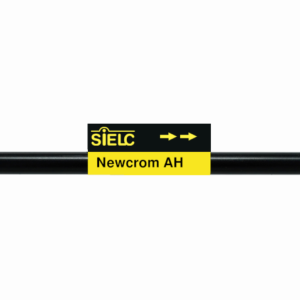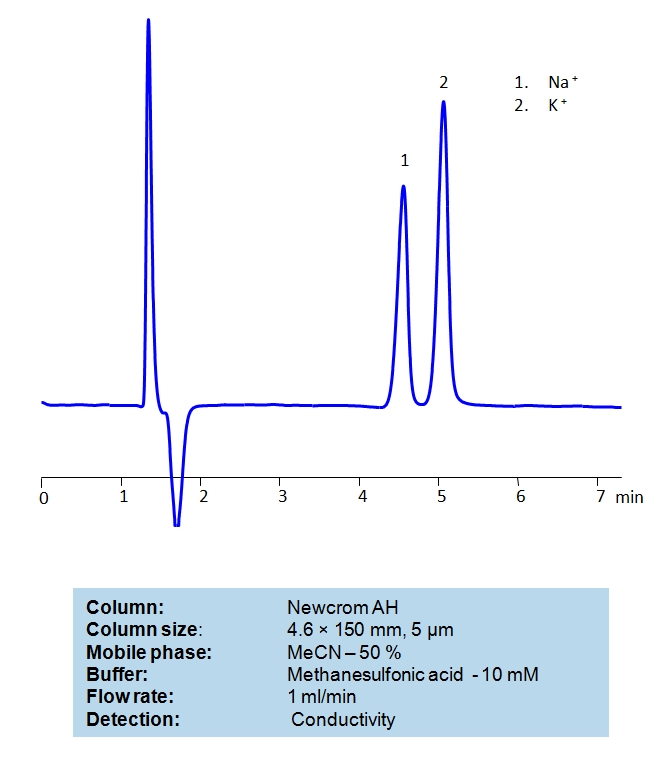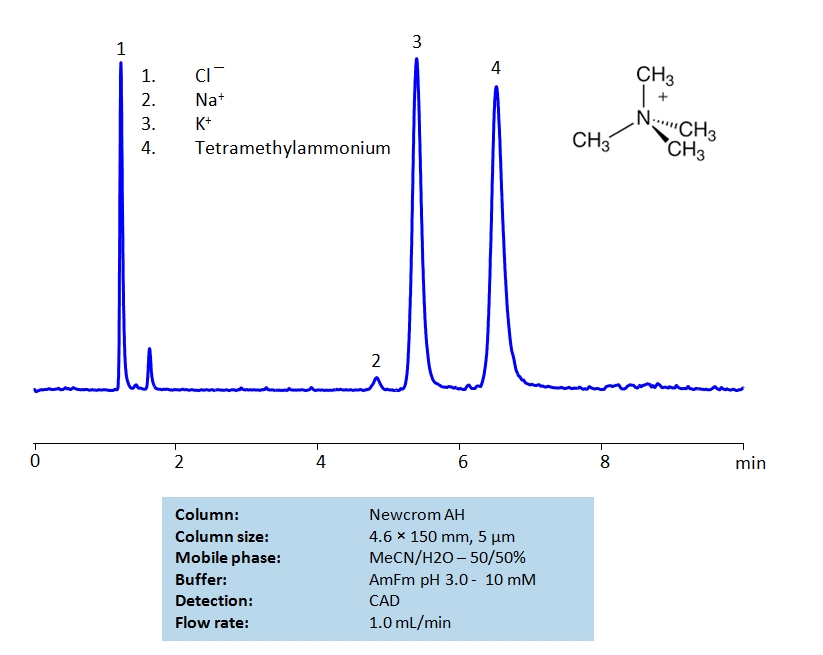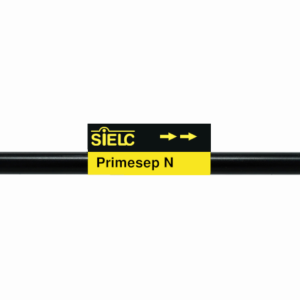| CAS Number | 7440-09-7 |
|---|---|
| Molecular Formula | K |
| Molecular Weight | 39.098 |
| InChI Key | NTTOTNSKUYCDAV-UHFFFAOYSA-N |
| Synonyms |
|
Applications:
HPLC Method for Separation of Sodium, Potassium, Lithium, and Ammonium on Primesep 100 Column
August 7, 2024
High Performance Liquid Chromatography (HPLC) Method for Analysis of Ammonium Ion, Lithium, Potassium, Sodium on Primesep 100 by SIELC Technologies
Separation type: Liquid Chromatography Mixed-mode
High Performance Liquid Chromatography (HPLC) Method for Analysis of Ammonium Ion, Lithium, Potassium, Sodium
Inorganic cations and ammonia are usually analyzed by ion-exchange chromatography with a conductivity detector. Mixed-mode chromatography achieves the same goal with an ELSD detector. In addition to retaining ions, mixed-mode column can retain hydrophobic molecules also, making it possible to analyze a wide variety of ionic and non-ionic compounds in one run. In this method sodium, potassium, and lithium ions were separated along with ammonium ions on a Primesep 100 column. Detection technique is ELSD.
| Column | Primesep 100, 4.6 x 250 mm, 5 µm, 100 A, dual ended |
| Mobile Phase | MeCN/H2O – 80/20% |
| Buffer | TFA – 0.1% |
| Flow Rate | 1.0 ml/min |
| Detection | ELSD, the nebulizer and evaporator temperatures 50°C, with a gas flow rate of 1.6 Standard Liters per Minute (SLM) |
| Class of Compounds | Ions, Hydrophilic, Ionizable, Vitamin, Supplements |
| Analyzing Compounds | Sodium, Potassium, Lithium, Ammonium |
Application Column
Primesep 100
Column Diameter: 4.6 mm
Column Length: 250 mm
Particle Size: 5 µm
Pore Size: 100 A
Column options: dual ended
Lithium
Potassium
Sodium

Separation of Silver and Potassium Ions on Newcrom AH Column
October 21, 2020
HPLC Method for Potassium, Silver on Newcrom AH by SIELC Technologies
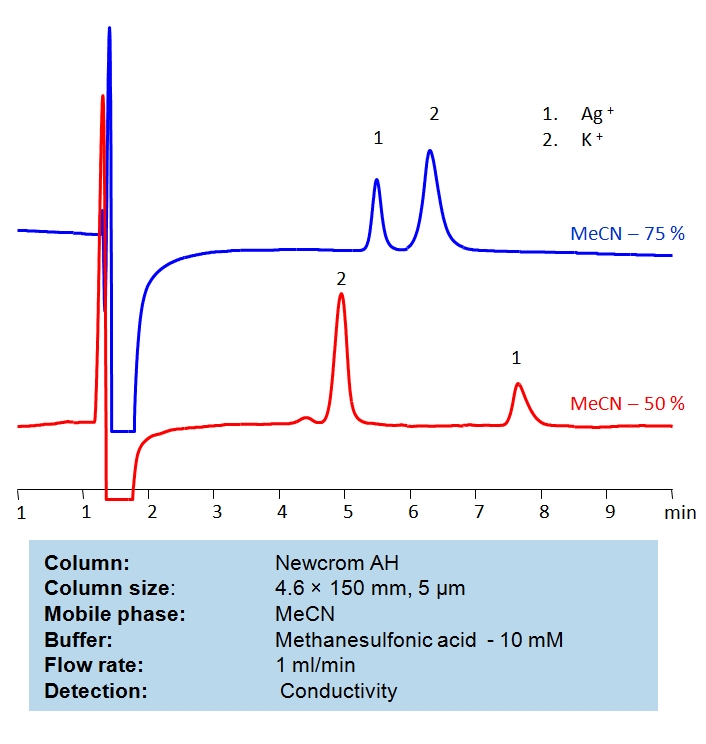
High Performance Liquid Chromatography (HPLC) Method for Analysis of Potassium, Silver.
Silver ions, Ag+, are positively charged silver atoms. They are known for having antimicrobial properties and can damage essential protein in microorganisms. Silver can also alter bacterial cell membranes, block the copying of genetic material, and prevent the formation of biofilms; though, most people tend to know silver as a shiny grey metal that is often used in jewelry.
Potassium ions, K+, are essential for cell function. They work as charge carriers inside animal cells to create the membrane. Imbalance of potassium can lead to debilitating health problems, but consumption of it through a diet can help regulate the negative effects of sodium on blood flow.
Silver and potassium ions can be separated on a mixed-mode Newcrom AH column with a simple isocratic mobile phase consisting of water, acetonitrile (ACN) and methanesulfonic acid. By adjusting the amount of acetonitrile used in the mobile phase, the elution order of the ions can be reversed. The ions can be detected using a conductivity detector.
| Column | Newcrom AH, 4.6 x 150 mm, 5 µm, 100 A, dual ended |
| Mobile Phase | MeCN |
| Buffer | Methanesulfonic acid – 10 mM |
| Flow Rate | 1.0 ml/min |
| Detection | Conductivity |
| Class of Compounds | Hydrophilic, Metal, Ion |
| Analyzing Compounds | Potassium, Silver |
Application Column
Newcrom AH
Column Diameter: 4.6 mm
Column Length: 150 mm
Particle Size: 5 µm
Pore Size: 100 A
Column options: dual ended
Silver

Separation of Sodium and Potassium Ions on Newcrom AH Column
October 21, 2020
HPLC Method for Sodium, Potassium on Newcrom AH by SIELC Technologies
Sodium Ions, Na+, are crucial for regulating fluid balance, transporting nutrients, and generating electrical signals within a body.
Potassium ions, K+, are essential for cell function. They work as charge carriers inside animal cells to create the membrane. Imbalance of potassium can lead to debilitating health problems, but consumption of it through a diet can help regulate the negative effects of sodium on blood flow.
Sodium and potassium ions can be separated on a mixed-mode Newcrom AH column with a simple isocratic mobile phase of water, acetonitrile (ACN) and methanesulfonic acid. It can be detected using a conductivity detector.
| Column | Newcrom AH, 4.6 x 150 mm, 5 µm, 100 A, dual ended |
| Mobile Phase | MeCN/H2O – 50/50% |
| Buffer | Methanesulfonic acid – 10 mM |
| Flow Rate | 1.0 ml/min |
| Detection | Conductivity |
| Class of Compounds | Hydrophilic, Metal, Ion |
| Analyzing Compounds | Sodium, Potassium |
Application Column
Newcrom AH
Column Diameter: 4.6 mm
Column Length: 150 mm
Particle Size: 5 µm
Pore Size: 100 A
Column options: dual ended
Sodium

HPLC Separation of Sodium, Potassium Ions and Tetramethylammonium Chloride on Newcrom AH Column
September 8, 2020
HPLC Method for Analysis of Tetramethylammonium, Sodium, Potassium on Newcrom AH by SIELC Technologies
High Performance Liquid Chromatography (HPLC) Method for Analysis of Tetramethylammonium, Sodium, Potassium.
Tetramethylammonium chloride is a quaternary ammonium salt used widely as a reagent in industrial applications. It can be separated from sodium and potassium chlorides on a mixed-mode Newcrom AH column with a simple isocratic MS-compatible mobile phase of water, acetonitrile (ACN) and ammonium formate (AmFm) buffer.
| Column | Newcrom AH, 4.6 x 150 mm, 5 µm, 100 A, dual ended |
| Mobile Phase | MeCN/H2O – 50/50% |
| Buffer | AmFm pH 3.0- 10 mM |
| Flow Rate | 1.0 ml/min |
| Detection | CAD (Corona) MS- compatible mobile phase |
| Class of Compounds | Hydrophilic, Metal, Ion, Quaternary ammonium salt |
| Analyzing Compounds | Tetramethylammonium, Sodium, Potassium |
Application Column
Newcrom AH
Column Diameter: 4.6 mm
Column Length: 150 mm
Particle Size: 5 µm
Pore Size: 100 A
Column options: dual ended
Sodium
Tetramethylammonium

Simultaneous Analysis of Glucose, Sodium, Potassium and Calcium Ions
July 8, 2011
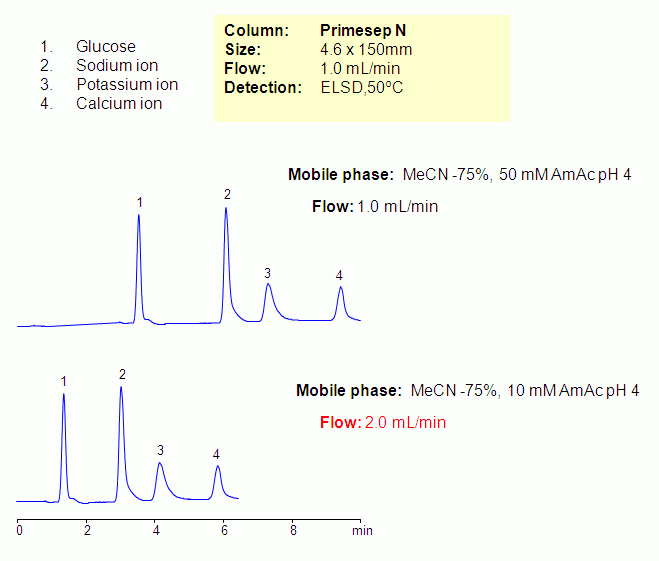
Neutral sugar, monovalent and divalent cations were separated in HILIC/cation-exchange mode on a Primesep N mixed-mode column. Mobile phase is compatible with LC/MS and method can be used for analysis polar molecules in HILIC, cation-exchange or anion-exclusion modes.
| Column | Primesep N, 4.6×150 mm, 5 µm, 100A |
| Mobile Phase | MeCN/H2O |
| Buffer | AmAc pH 4.0 |
| Flow Rate | 1.0 ml/min |
| Detection | ELSD 50C |
| Class of Compounds |
Ions, Hydrophilic, Ionizable |
| Analyzing Compounds | Potassium, Sodium, Calcium, Glucose |
Application Column
Primesep N
Column Diameter: 4.6 mm
Column Length: 150 mm
Particle Size: 5 µm
Pore Size: 100 A
Column options: dual ended
Glucose
Potassium
Sodium

HPLC Separation of Potassium, Perchlorate, Methanesulfonic, Chloride, Bromide, and Nitrate Ions on Obelisc N
March 3, 2010
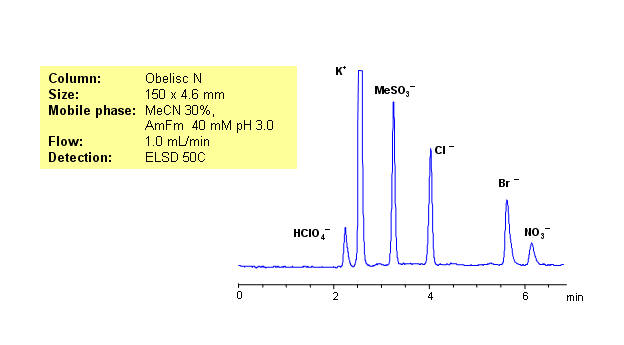
Ion chromatography is usually used for analysis of hydrophilic organic and inorganic ions. Same separation can be achieved on HILIC/mixed-mode Obelisc N HPLC columns. Obelisc N HPLC columns have very polar groups on their surface: one of the groups is basic and the other acidic. In case of low organic concentration, two groups are connected by hydrophilic linker. Obelisc N column can be used as cation-exchange and anion-exchange column. This allows to separate positively and negatively charged molecules in one run. Five anions (chloride, bromide, methanesulfonate, nitrate and perchlorate) along with one cation (sodium) were separated in one run. Method is compatible with ELSD, CAD and LC/MS and can be used for analysis of various hydrophilic and hydrophobic cations and anions in one HPLC run.
| Column | Obelisc N, 4.6×150 mm, 5 µm, 100A |
| Mobile Phase | MeCN/H2O |
| Buffer | AmFm |
| Flow Rate | 1.0 ml/min |
| Detection | ELSD |
| Class of Compounds |
Hydrophilic, Ions |
| Analyzing Compounds | Chloride, Nitrate, Chlorate, Bromide, Potassium |
Application Column
Obelisc N
SIELC has developed the Obelisc™ columns, which are mixed-mode and utilize Liquid Separation Cell technology (LiSC™). These cost-effective columns are the first of their kind to be commercially available and can replace multiple HPLC columns, including reversed-phase (RP), AQ-type reversed-phase, polar-embedded group RP columns, normal-phase, cation-exchange, anion-exchange, ion-exclusion, and HILIC (Hydrophilic Interaction Liquid Chromatography) columns. By controlling just three orthogonal method parameters - buffer concentration, buffer pH, and organic modifier concentration - users can adjust the column properties with pinpoint precision to separate complex mixtures.
Select optionsChloride
Methanesulfonic Acid
Nitrate
Nitric Acid
Potassium

Reverse Elution Order in Separation of Alkali Cation
August 12, 2006
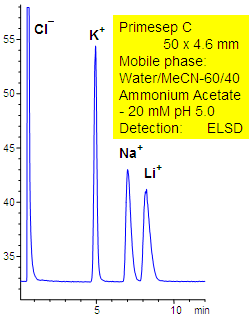
Primesep C separates a mixture of inorganic cations, potassium, sodium, and lithium, by a combination of cation exchange and complex formation. The peak order is reversed on the Primesep C column compared to the order normally obtained on columns that rely on cation exchange alone. The mobile phase mixture of water, acetonitrile (MeCN, ACN) and ammonium acetate is compatible with UV and evaporative light scattering detection (ELSD).
| Column | Primesep C, 4.6×50 mm, 5 µm, 100A |
| Mobile Phase | MeCN/H2O |
| Buffer | AmAc |
| Flow Rate | 1.0 ml/min |
| Detection | ELSD 50C |
| Class of Compounds |
Ions, Hydrophilic, Ionizable, Vitamin, Supplements |
| Analyzing Compounds | Sodium, Potassium, Lithium, Chloride |
Application Column
Primesep C
The Primesep family of mixed-mode columns offers a wide variety of stationary phases, boasting unprecedented selectivity in the separation of a broad array of chemical compounds across multiple applications. Corresponding Primesep guard columns, available with all stationary phases, do not require holders. SIELC provides a method development service available to all customers. Inquire about our specially-tailored custom LC-phases for specific separations.
Select optionsPotassium
Sodium

Effect of Concentration of Organic Modifier on Retention of Cation and Anions
November 20, 2005
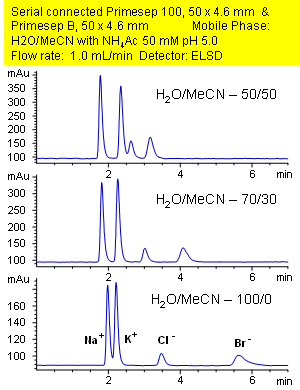
Primesep 100 and Primesep B columns connected in series allow the quantitation of sodium chloride and potassium bromide ions in one injection. The Primesep B column retains the chloride and bromide anions by anion exchange, and the Primesep 100 retains the sodium and potassium cations by cation exchange. The retention can be adjusted by changing the water/acetonitrile ratio in the mobile phase. The separation uses a mobile phase mixture of water, acetonitrile (MeCN, ACN) and ammonium acetate with evaporative light scattering detection (ELSD).
| Column | Primesep 100, Primesep B , 4.6×50 mm, 5 µm, 100A |
| Mobile Phase | MeCN/H2O |
| Buffer | AmAc pH 5.0 |
| Flow Rate | 1.0 ml/min |
| Detection | ELSD |
| Class of Compounds |
Ions, Hydrophilic, Ionizable, Vitamin, Supplements |
| Analyzing Compounds | Sodium, Potassium, Bromide, Chloride |
Application Column
Primesep 100
The Primesep family of mixed-mode columns offers a wide variety of stationary phases, boasting unprecedented selectivity in the separation of a broad array of chemical compounds across multiple applications. Corresponding Primesep guard columns, available with all stationary phases, do not require holders. SIELC provides a method development service available to all customers. Inquire about our specially-tailored custom LC-phases for specific separations.
Select optionsPrimesep B
The Primesep family of mixed-mode columns offers a wide variety of stationary phases, boasting unprecedented selectivity in the separation of a broad array of chemical compounds across multiple applications. Corresponding Primesep guard columns, available with all stationary phases, do not require holders. SIELC provides a method development service available to all customers. Inquire about our specially-tailored custom LC-phases for specific separations.
Select optionsChloride
Potassium
Sodium

Simultaneous Separation of Cations and Anions
November 15, 2005
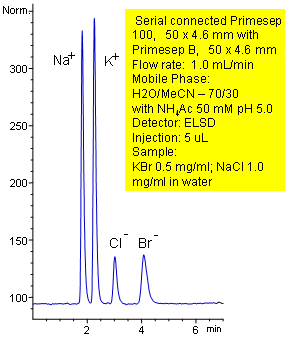
Primesep 100 and Primesep B columns connected in series allow the quantitation of sodium chloride and potassium bromide ions in one injection. The Primesep B column retains the chloride and bromide anions by anion exchange, and the Primesep 100 retains the sodium and potassium captions by cation exchange. The separation uses a mobile phase mixture of water, acetonitrile (MeCN, ACN) and trifluoroacetic acid (TFA) with evaporative light scattering detection (ELSD).
| Column | Primesep 100, Primesep B , 4.6×50 mm, 5 µm, 100A |
| Mobile Phase | MeCN/H2O |
| Buffer | AmAc pH 5.0 |
| Flow Rate | 1.0 ml/min |
| Detection | ELSD 50C |
| Class of Compounds |
Ions, Hydrophilic, Ionizable, Vitamin, Supplements |
| Analyzing Compounds | Sodium, Potassium, Bromide, Chloride |
Application Column
Primesep 100
The Primesep family of mixed-mode columns offers a wide variety of stationary phases, boasting unprecedented selectivity in the separation of a broad array of chemical compounds across multiple applications. Corresponding Primesep guard columns, available with all stationary phases, do not require holders. SIELC provides a method development service available to all customers. Inquire about our specially-tailored custom LC-phases for specific separations.
Select optionsPrimesep B
The Primesep family of mixed-mode columns offers a wide variety of stationary phases, boasting unprecedented selectivity in the separation of a broad array of chemical compounds across multiple applications. Corresponding Primesep guard columns, available with all stationary phases, do not require holders. SIELC provides a method development service available to all customers. Inquire about our specially-tailored custom LC-phases for specific separations.
Select optionsChloride
Potassium
Sodium

Complex of Cations on Primesep C is Effected by Organic Modifier
October 15, 2005
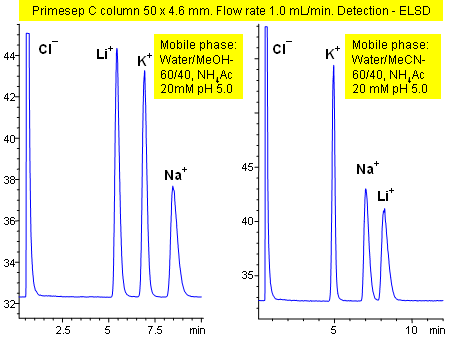
Primesep C separates a mixture of inorganic cations, potassium, sodium, and lithium, by a combination of cation exchange and complex formation. The peak order is reversed on the Primesep C column compared to the order normally obtained on columns that rely on cation exchange alone. In addition, the elution order can be rearranged by simply changing the organic modifier in the mobile phase from acetonitrile to methanol. The mobile phase mixture of water, acetonitrile (MeCN, ACN) or methanol (MeOH) and ammonium acetate is compatible with UV and evaporative light scattering detection (ELSD).
| Column | Primesep C, 4.6×50 mm, 5 µm, 100A |
| Mobile Phase | MeOH, MeCN |
| Buffer | AmAc pH 5.0 |
| Flow Rate | 1.0 ml/min |
| Detection | ELSD 50C |
| Class of Compounds |
Ions, Hydrophilic, Ionizable, Vitamin, Supplements |
| Analyzing Compounds | Sodium, Potassium, Lithium, Chloride |
Application Column
Primesep C
The Primesep family of mixed-mode columns offers a wide variety of stationary phases, boasting unprecedented selectivity in the separation of a broad array of chemical compounds across multiple applications. Corresponding Primesep guard columns, available with all stationary phases, do not require holders. SIELC provides a method development service available to all customers. Inquire about our specially-tailored custom LC-phases for specific separations.
Select optionsPotassium
Sodium

HPLC ELSD Method for Separation of Metal Ions on Primesep 100 Column
October 4, 2005
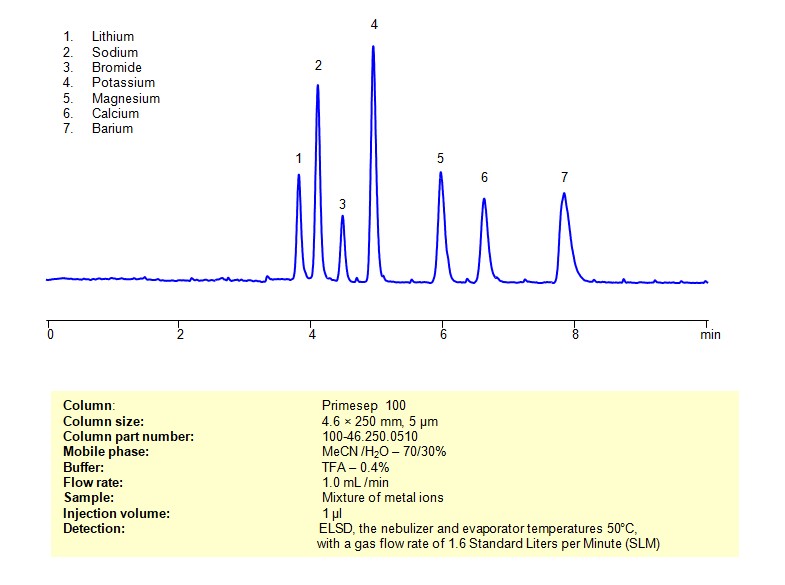
Primesep 100 separates the monovalent cations, lithium, potassium, and sodium, and the divalent cations, zinc, manganese, and calcium. The cations are resolved by cation exchange. The mobile phase mixture of water, acetonitrile (MeCN, ACN) and trifluoroacetic acid (TFA) is evaporative light scattering detection (ELSD) compatible.
| Column | Primesep 100, 4.6×250 mm, 5 µm, 100A |
| Mobile Phase | MeCN/H2O – 70/30% |
| Buffer | TFA- 0.4% |
| Flow Rate | 1.0 ml/min |
| Detection | ELSD 50C |
| Class of Compounds | Ions, Hydrophilic, Ionizable, Vitamin, Supplements |
| Analyzing Compounds | Sodium, Magnesium, Calcium, Lithium, Barium |
Application Column
Primesep 100
Column Diameter: 4.6 mm
Column Length: 250 mm
Particle Size: 5 µm
Pore Size: 100 A
Column options: dual ended
Bromide
Calcium
Lithium
Magnesium
Potassium
Sodium

Potassium Analysis in Organic Reaction Product
August 12, 2003
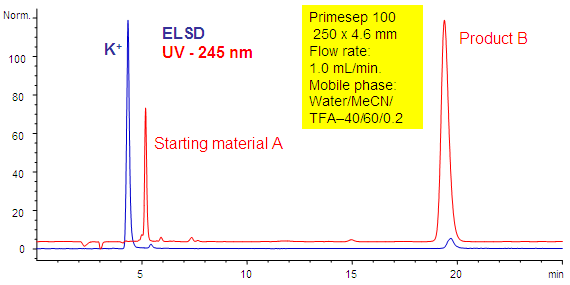
Primesep 100 separates a mixture of an organic starting material, its product, and residual potassium ion. The potassium cation is retained by cation exchange and the organic starting material and product are retained by hydrophobic and ionic interactions. The mobile phase mixture of water, acetonitrile (MeCN, ACN) and trifluoroacetic acid (TFA) is UV, MS, and evaporative light scattering detection (ELSD) compatible.
Application Column
Primesep 100
The Primesep family of mixed-mode columns offers a wide variety of stationary phases, boasting unprecedented selectivity in the separation of a broad array of chemical compounds across multiple applications. Corresponding Primesep guard columns, available with all stationary phases, do not require holders. SIELC provides a method development service available to all customers. Inquire about our specially-tailored custom LC-phases for specific separations.
Select optionsUV Detection



